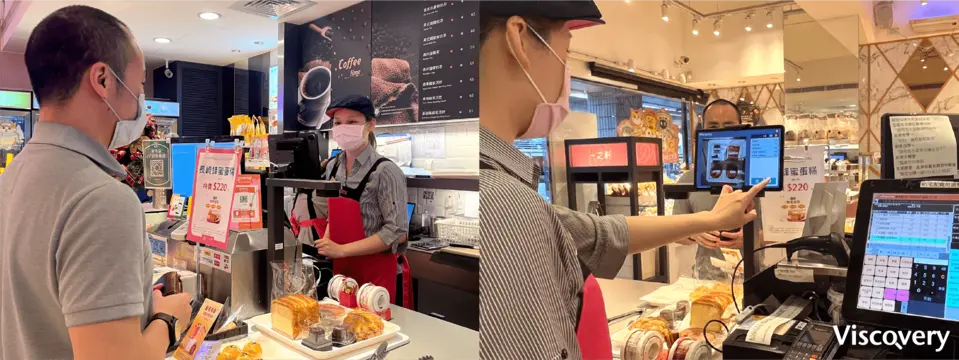
What is POS? Explore the 2024 Checkout Technology Trends
April 26, 2024
Ever wonder about the machine the cashier uses when you are finished eating or ready to pay? Whether it’s big and clunky or sleek like a tablet, that handy device is called a POS (Point of Sale).
POS is the checkout system that many businesses use to process transactions and keep track of sales. As businesses evolve, POS systems offer a wider range of features. Moreover, the hardware itself is becoming lighter and more adaptable, and can even be automated with AI to work more efficiently.
The Century-long Evolution of POS
In the days before machines, business transactions relied on manual records, akin to the ledgers seen in period dramas—bulky and hard to manage. Manual bookkeeping was also error-prone and vulnerable to employee fraud, making it difficult to keep track of revenue.
Back in 1879, a bar owner in the United States, fed up with ongoing revenue losses from employee theft, invented a mechanical device resembling a typewriter. Its purpose was to efficiently and accurately record each transaction amount. This invention was called the Cash Register. 1
In 1973, IBM developed the computer-driven cash register, but it wasn’t what we commonly recognize as the POS today. Instead, it was the Electronic Cash Register (ECR), often found in grocery stores and traditional restaurants nowadays, featuring only a keyboard and a small display screen for showing the amount. 1
In 1985, IBM introduced the POS terminal as we know it today, revolutionizing checkout with greater efficiency and ease of management. 1

Tablets: Innovators in the POS Market
As tablets became increasingly common, people started to ponder whether the clunky POS systems could be transformed into tablets.
The once dominant Windows POS began facing competition from iOS and Android tablet POS systems, leading to greater diversity in POS software.
Stores now have more options for purchasing POS. Instead of buying everything upfront, they can subscribe to tablet POS services, buying only the tablet and paying a monthly fee for the software.
Compared with traditional POS hardware, which usually cost between USD 1,500 to USD 3,500, tablets range from USD 150 to USD 700. This makes opening a store much more affordable for businesses nowadays.
The price drop isn’t the only benefit. Transitioning from heavy POS systems to tablets not only frees up valuable space at checkout counters but also offers intuitive software with sleek designs that seamlessly match any business decor. Lightweight POS tablets are gaining popularity among stores.

Innovations in POS Peripherals
Alongside the advancements in POS terminal, peripherals for POS have also undergone significant evolution. From traditional keyboards and barcode scanners to modern touchscreen panels and AI image recognition tools, these technological advancements have dramatically improved checkout efficiency and accuracy.
Take bakery for example. Prior to the introduction of touchscreen panels, cashiers had to manually input items or amounts using a keyboard. With touchscreen POS systems now available, cashiers can directly select bakery items on the screen. However, handling a large number of items still results in longer checkout times.
As I Jy Sheng, a bakery chain in Taiwan, shared, their experienced cashiers took approximately 22 seconds to identify and input six different bread items into the POS system manually.
To streamline the checkout process, I Jy Sheng integrated Viscovery’s AI-powered image recognition technology with its POS system and reduced the recognition and input time from 22 seconds to just 1 second.
AI helps simplify the checkout process, resulting in faster service for customers and enabling cashiers to focus more on customer interaction.
What more, the time spent training staff to memorize bread items is significantly reduced, enhancing operational efficiency.
It’s worth noting that the AI system can seamlessly integrate with stores’ existing checkout systems, whether traditional POS or tablet-based. This integration does not require a substantial investment in new checkout systems, making it easier for businesses to adopt and gain a competitive edge.

(Photo by Viscovery)
Choosing the Right Checkout Tool for Your Business
With various checkout tools available, including AI image recognition, RFID, and Amazon Go’s “grab and go” solution, it’s essential to choose the one that meets your product and business needs.
Like I Jy Sheng, numerous bakeries and restaurants have also adopted AI recognition systems. For instance, RT Baker House, Hi Noodle, a Chinese noodle shop part of the Haidilao hotpot chain in Singapore, as well as micromarkets and pastry shops in Japan, have all joined the trend.
Through human-machine collaboration, these new technologies have shortened checkout times, improved operational efficiency, and made the shopping experience better for customers.
Related Article: How to Choose POS System in 2024: A Seven-Step Guide

(Featured image: Photo by Blake Wisz on Unsplash)
[References]
1 “The History Of Point Of Sale In Five Key Steps.” Retail Technology Group. https://rtgpos.com/news/the-history-of-point-of-sale-in-five-key-steps/.

